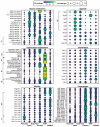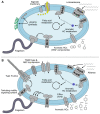Comparative Proteomics of Marinobacter sp. TT1 Reveals Corexit Impacts on Hydrocarbon Metabolism, Chemotactic Motility, and Biofilm Formation
- PMID: 33374976
- PMCID: PMC7822026
- DOI: 10.3390/microorganisms9010003
Comparative Proteomics of Marinobacter sp. TT1 Reveals Corexit Impacts on Hydrocarbon Metabolism, Chemotactic Motility, and Biofilm Formation
Abstract
The application of chemical dispersants during marine oil spills can affect the community composition and activity of marine microorganisms. Several studies have indicated that certain marine hydrocarbon-degrading bacteria, such as Marinobacter spp., can be inhibited by chemical dispersants, resulting in lower abundances and/or reduced biodegradation rates. However, a major knowledge gap exists regarding the mechanisms underlying these physiological effects. Here, we performed comparative proteomics of the Deepwater Horizon isolate Marinobacter sp. TT1 grown under different conditions. Strain TT1 received different carbon sources (pyruvate vs. n-hexadecane) with and without added dispersant (Corexit EC9500A). Additional treatments contained crude oil in the form of a water-accommodated fraction (WAF) or chemically-enhanced WAF (CEWAF; with Corexit). For the first time, we identified the proteins associated with alkane metabolism and alginate biosynthesis in strain TT1, report on its potential for aromatic hydrocarbon biodegradation and present a protein-based proposed metabolism of Corexit components as carbon substrates. Our findings revealed that Corexit exposure affects hydrocarbon metabolism, chemotactic motility, biofilm formation, and induces solvent tolerance mechanisms, like efflux pumps, in strain TT1. This study provides novel insights into dispersant impacts on microbial hydrocarbon degraders that should be taken into consideration for future oil spill response actions.
Keywords: Corexit; Marinobacter; WAF; biofilm formation; chemotactic motility; dispersant; hexadecane; hydrocarbon metabolism; proteomics.
Conflict of interest statement
The authors declare no conflict of interest.
Figures



Similar articles
-
Corexit 9500 Enhances Oil Biodegradation and Changes Active Bacterial Community Structure of Oil-Enriched Microcosms.Appl Environ Microbiol. 2017 May 1;83(10):e03462-16. doi: 10.1128/AEM.03462-16. Print 2017 May 15. Appl Environ Microbiol. 2017. PMID: 28283527 Free PMC article.
-
Rapid Formation of Microbe-Oil Aggregates and Changes in Community Composition in Coastal Surface Water Following Exposure to Oil and the Dispersant Corexit.Front Microbiol. 2018 Apr 11;9:689. doi: 10.3389/fmicb.2018.00689. eCollection 2018. Front Microbiol. 2018. PMID: 29696005 Free PMC article.
-
Metatranscriptomic response of deep ocean microbial populations to infusions of oil and/or synthetic chemical dispersant.Appl Environ Microbiol. 2024 Aug 21;90(8):e0108324. doi: 10.1128/aem.01083-24. Epub 2024 Jul 23. Appl Environ Microbiol. 2024. PMID: 39041797 Free PMC article.
-
Response of natural phytoplankton communities exposed to crude oil and chemical dispersants during a mesocosm experiment.Aquat Toxicol. 2019 Jan;206:43-53. doi: 10.1016/j.aquatox.2018.11.004. Epub 2018 Nov 6. Aquat Toxicol. 2019. PMID: 30448744
-
Extracellular polymeric substances (EPS) producing and oil degrading bacteria isolated from the northern Gulf of Mexico.PLoS One. 2018 Dec 6;13(12):e0208406. doi: 10.1371/journal.pone.0208406. eCollection 2018. PLoS One. 2018. PMID: 30521589 Free PMC article.
Cited by
-
Impacts of dispersants on microbial communities and ecological systems.Appl Microbiol Biotechnol. 2023 Feb;107(4):1095-1106. doi: 10.1007/s00253-022-12332-z. Epub 2023 Jan 17. Appl Microbiol Biotechnol. 2023. PMID: 36648524 Free PMC article. Review.
-
Response and oil degradation activities of a northeast Atlantic bacterial community to biogenic and synthetic surfactants.Microbiome. 2021 Sep 21;9(1):191. doi: 10.1186/s40168-021-01143-5. Microbiome. 2021. PMID: 34548108 Free PMC article.
-
Insight Into the Molecular Mechanisms Underpinning the Mycoremediation of Multiple Metals by Proteomic Technique.Front Microbiol. 2022 Jun 3;13:872576. doi: 10.3389/fmicb.2022.872576. eCollection 2022. Front Microbiol. 2022. PMID: 35756008 Free PMC article.
-
Unveiling fungal strategies: Mycoremediation in multi-metal pesticide environment using proteomics.Sci Rep. 2024 Oct 5;14(1):23171. doi: 10.1038/s41598-024-74517-y. Sci Rep. 2024. PMID: 39369035 Free PMC article.
-
Evaluation of Differentially Expressed Candidate Genes in Benzo[a]pyrene Degradation by Burkholderia vietnamiensis G4.Mol Biotechnol. 2024 Sep 19. doi: 10.1007/s12033-024-01284-6. Online ahead of print. Mol Biotechnol. 2024. PMID: 39298104
References
-
- US Nature Communications . Deepwater Horizon (DWH). The Use of Surface and Subsea Dispersants during the BP Deepwater Horizon Oil Spill. US Nature Communications; Washington, DC, USA: 2011.
-
- Doyle S.M., Whitaker E.A., De Pascuale V., Wade T.L., Knap A.H., Santschi P.H., Quigg A., Sylvan J.B. Rapid formation of microbe-oil aggregates and changes in community composition in coastal surface water following exposure to oil and the dispersant Corexit. Front. Microbiol. 2018;9:689. doi: 10.3389/fmicb.2018.00689. - DOI - PMC - PubMed
-
- Kleindienst S., Seidel M., Ziervogel K., Grim S.L., Loftis K.M., Harrison S., Malkin S.Y., Perkins M.J., Field J.A., Sogin M.L., et al. Chemical dispersants can suppress the activity of natural oil-degrading microorganisms. Proc. Natl. Acad. Sci. USA. 2015;112:14900–14905. doi: 10.1073/pnas.1507380112. - DOI - PMC - PubMed
Grants and funding
LinkOut - more resources
Full Text Sources
Molecular Biology Databases
Miscellaneous

